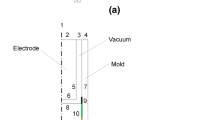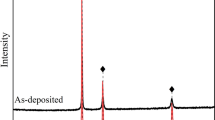Abstract
A contact model that accounts for interfacial cohesion and thermal conduction is developed to investigate the influence of bonding on the final residual stresses build-up in cold spray. The residual stress evolution in the cold-sprayed Al-6061 coating on an Al-6061 substrate is investigated via three-dimensional single-particle and multi-particle impact simulations. It is shown that the interface bonding mainly affects the local residual stress distribution near the interfaces. The residual stresses are largely due to the kinetic peening and bonding effects. The thermal cooling has negligible influence. In general, this work finds that peening introduces compressive stress, while bonding causes relaxation. The balance between the peening and the bonding effects, which depends strongly on the local bonding environment, determines the final residual stress in the system. This work suggests that the interface bonding should be considered as one of the essential factors in numerical modeling of the residual stresses evolution in cold spray.








Similar content being viewed by others
References
H. Assadi, F. Gärtner, T. Stoltenhoff, and H. Kreye, Bonding Mechanism in Cold Gas Spraying, Acta Mater., 2003, 51, p 4379-4394
T. Schmidt, F. Gärtner, H. Assadi, and H. Kreye, Development of a Generalized Parameter Window for Cold Spray Deposition, Acta Mater., 2006, 54, p 729-742
R. Ghelichi, D. MacDonald, S. Bagherifard, H. Jahed, M. Guagliano, and B. Jodoin, Microstructure and Fatigue Behavior of Cold Spray Coated Al5052, Acta Mater., 2012, 60, p 6555-6561
C.W. Ziemian, M.M. Sharma, B.D. Bouffard, T. Nissley, and T.J. Eden, Effect of Substrate Surface Roughening and Cold Spray Coating on the Fatigue Life of AA2024 Specimens, Mater. Des. (1980-2015), 2014, 54, p 212-221
Z. Arabgol, H. Assadi, T. Schmidt, F. Gärtner, and T. Klassen, Analysis of Thermal History and Residual Stress in Cold-Sprayed Coatings, J. Therm. Spray Technol., 2014, 23, p 84-90
T. Suhonen, T. Varis, S. Dosta, M. Torrell, and J.M. Guilemany, Residual Stress Development in Cold Sprayed Al, Cu and Ti Coatings, Acta Mater., 2013, 61, p 6329-6337
M.R. Rokni, C.A. Widener, O.C. Ozdemir, and G.A. Crawford, Microstructure and Mechanical Properties of Cold Sprayed 6061 Al in As-Sprayed and Heat Treated Condition, Surf. Coat. Technol., 2017, 309, p 641-650
G. Shayegan, H. Mahmoudi, R. Ghelichi, J. Villafuerte, J. Wang, M. Guagliano et al., Residual Stress Induced by Cold Spray Coating of Magnesium AZ31B Extrusion, Mater. Des., 2014, 60, p 72-84
V. Luzin, K. Spencer, and M.X. Zhang, Residual Stress and Thermo-mechanical Properties of Cold Spray Metal Coatings, Acta Mater., 2011, 59, p 1259-1270
K. Spencer, V. Luzin, N. Matthews, and M.X. Zhang, Residual Stresses in Cold Spray Al Coatings: The Effect of Alloying and of Process Parameters, Surf. Coat. Technol., 2012, 206, p 4249-4255
S. Rech, A. Trentin, S. Vezzù, J.-G. Legoux, E. Irissou, and M. Guagliano, Influence of Pre-Heated Al 6061 Substrate Temperature on the Residual Stresses of Multipass Al Coatings Deposited by Cold Spray, J. Therm. Spray Technol., 2011, 20, p 243-251
M. Saleh, V. Luzin, and K. Spencer, Analysis of the Residual Stress and Bonding Mechanism in the Cold Spray Technique Using Experimental and Numerical Methods, Surf. Coat. Technol., 2014, 252, p 15-28
R. Ghelichi, S. Bagherifard, D. MacDonald, I. Fernandez-Pariente, B. Jodoin, and M. Guagliano, Experimental and Numerical Study of Residual Stress Evolution in Cold Spray Coating, Appl. Surf. Sci., 2014, 288, p 26-33
W. Li, K. Yang, D. Zhang, and X. Zhou, Residual Stress Analysis of Cold-Sprayed Copper Coatings by Numerical Simulation, J. Therm. Spray Technol., 2016, 25, p 131-142
ABAQUS/CAE User’s Manual: Version 6.13 (ABAQUS, Pawtucket, 2012)
O.C. Ozdemir, C.A. Widener, D. Helfritch, and F. Delfanian, Estimating the Effect of Helium and Nitrogen Mixing on Deposition Efficiency in Cold Spray, J. Therm. Spray Technol., 2016, 25, p 660-671
G.R. Johnson and W.H. Cook, A Constitutive Model and Data for Metals Subjected to Large Strains, High Strain Rates, and High Temperatures, in Proceedings 7th International Symposium on Ballistics (1983), pp. 541-547
A. Alizadeh Dehkharghani, Tuning Johnson–Cook Material Model Parameters for Impact of High Velocity, Micron Scale Aluminum Particles. Master Thesis (Northeastern University, Boston, 2016)
W. Xie, A. Alizadeh-Dehkharghani, Q. Chen, V.K. Champagne, X. Wang, A.T. Nardi et al., Dynamics and Extreme Plasticity of Metallic Microparticles in Supersonic Collisions, Sci. Rep., 2017, 7, p 5073
M.A. Meyers, Plastic Deformation at High Strain Rates. Dynamic Behavior of Materials, Wiley, New York, 2007, p 323-381
JAHM Software Inc., Material Properties Database. MPDB (2003); V7.01 demo
B. Yildirim, S. Muftu, and A. Gouldstone, Modeling of High Velocity Impact of Spherical Particles, Wear, 2011, 270, p 703-713
G.R. Johnson and W.H. Cook, Fracture Characteristics of Three Metals Subjected to Various Strains, Strain Rates, Temperatures and Pressures, Eng. Fract. Mech., 1985, 21, p 31-48
A. Manes, D. Lumassi, L. Giudici, and M. Giglio, An Experimental-Numerical Investigation on Aluminium Tubes Subjected to Ballistic Impact with Soft Core 7.62 Ball Projectiles, Thin Walled Struct., 2013, 73, p 68-80
M. Hassani-Gangaraj, D. Veysset, K.A. Nelson, and C.A. Schuh, In-Situ Observations of Single Micro-particle Impact Bonding, Scr. Mater., 2018, 145, p 9-13
V.V. Bulatov, B.W. Reed, and M. Kumar, Grain Boundary Energy Function for FCC Metals, Acta Mater., 2014, 65, p 161-175
B. Yildirim, H. Fukanuma, T. Ando, A. Gouldstone, and S. Müftü, A Numerical Investigation Into Cold Spray Bonding Processes, J. Tribol., 2014, 137, p 011102-011113
S. Müftü, S. Zhalehpour, A. Gouldstone, and T. Ando, Assessment of Interface Energy in High Velocity Particle Impacts, in 38th Annual Meeting of The Adhesion Society. Savannah, GA (2015)
B.M. Gabriel, V.K. Champagne, P.F. Leaman, and D.J. Helfritch, Cold Spray for Repair of Magnesium Components. Army Research Library Report No ARL-TR-6629 (2013)
S. Kikuchi, Y. Hirota, and J. Komotori, Effects of Particle Size for Peening on Microstructural Changes in Steel, J. Jpn. Soc. Abras. Technol., 2010, 54, p 720-724
Acknowledgment
This work was sponsored in part by the Army Research Laboratories under the Grant Number W911NF-15-2-0026. Any opinions, findings and conclusions or recommendations expressed in this material are those of the author(s) and do not necessarily reflect the views of the US Government.
Author information
Authors and Affiliations
Corresponding authors
Electronic supplementary material
Below is the link to the electronic supplementary material.
Appendix
Appendix
The proposed surface contact model (Fig. 3) is implemented in ABAQUS/Explicit through a user subroutine VUINTERACTION. To verify the implementation, the separation-traction history for the contact pair between south pole of the particle and center point of the substrate in the cohesive region (δn > 0) is monitored throughout the single-particle impact simulation, as shown in Fig. S1. Each black circle in Fig. S1 represents the separation-traction relationship at the monitored simulation time step. It is clearly seen that the traction follows the assumed bilinear cohesive behaviors with δn, as expected. The values of the monitored cohesive stiffness kcoh = 1011 MPa/mm, cohesive strength σ0 = 325 MPa and cohesive damage energy G = 1.0 J/m2 are exactly the same as those that are input to the code (listed in Table 1). In Fig. S1, it is also seen that after the onset of cohesive damage (\(\sigma_{t}^{n} > \sigma_{0}\) or δn > δnc), the traction follows the degraded kcoh to load and unloading with δn until its final failure.
Rights and permissions
About this article
Cite this article
Lin, E., Chen, Q., Ozdemir, O.C. et al. Effects of Interface Bonding on the Residual Stresses in Cold-Sprayed Al-6061: A Numerical Investigation. J Therm Spray Tech 28, 472–483 (2019). https://doi.org/10.1007/s11666-019-00827-7
Received:
Revised:
Published:
Issue Date:
DOI: https://doi.org/10.1007/s11666-019-00827-7




